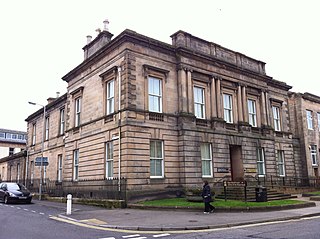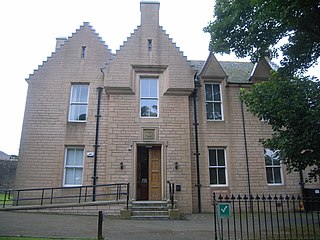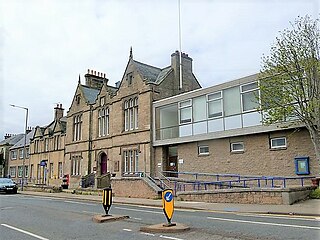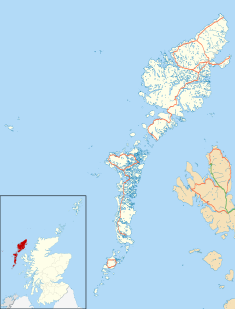
HMY Iolaire was an iron-hulled steam yacht that was launched in Scotland in 1881 as Iolanthe. She was renamed Mione in 1898; Iolanthe in 1900; and Amalthæa in 1907. Between 1881 and 1915 a succession of industrialists and aristocrats had owned the yacht. She was commissioned into the Royal Navy in 1915 as HMY Amalthaea, and renamed HMY Iolaire in 1918. She was wrecked in a storm at the mouth of Stornoway harbour on New Year's Day 1919. The disaster killed more than 200 people, including many of the young men of the isles of Lewis and Harris. UK law now protects her wreck as a war grave.

Greenock Sheriff Court is a judicial building on Nelson Street in Greenock in Scotland. The structure, which continues to operate as a courthouse, is a Category B listed building.

Tain Tolbooth is a municipal building in the High Street, Tain, Highland, Scotland. The structure, which is used as a courthouse, is a Category A listed building.

Elgin Sheriff Court is a courthouse in the High Street, Elgin, Moray, Scotland. The structure is a Category B listed building.

Kirkwall Sheriff Court is a judicial structure in Watergate, Kirkwall, Orkney, Scotland. The structure, which was the headquarters of Orkney County Council and is currently used as a courthouse, is a Category C listed building.

County Buildings is a municipal structure in Newtown Street, Duns, Scottish Borders, Scotland. The complex, which was the headquarters of Berwickshire County Council and was also used as a courthouse, is a Category C listed building.

County Buildings is a municipal structure in Drysdale Street, Alloa, Clackmannanshire, Scotland. The structure, which was the headquarters of Clackmannanshire County Council and is currently used as courthouse, is a Category B listed building.

Stranraer Sheriff Court is a judicial building in Lewis Street, Stranraer, Dumfries and Galloway, Scotland. The building, which continues to be used as a courthouse, is a Category B listed building.

Forfar Sheriff Court is a judicial building in Market Street, Forfar, Angus, Scotland. The building, which remains in use as a courthouse, is a Category B listed building.

Oban Sheriff Court is a judicial building on Albany Street in Oban in Scotland. The building, which remains in use as a courthouse, is a Category B listed building.

The Old Sheriff Court is a judicial building on Hope Street in Falkirk in Scotland. The building, which currently accommodates a firm of funeral directors, is a Category B listed building.

Kilmarnock Sheriff Court is a judicial building on St Marnock Street in Kilmarnock in Scotland. The building operates as a courthouse within the sheriffdom of North Strathclyde.

The Old Sheriff Court is a judicial building on St Marnock Street in Kilmarnock in Scotland. The building, which currently accommodates the procurator fiscal's office, is a Category B listed building.

Kirkcaldy Sheriff Court, formerly known as County Buildings, is a judicial building on Whytescauseway in Kirkcaldy in Scotland. The building, which continues to operate a courthouse, is a Category B listed building.

Linlithgow Sheriff Court is a former judicial building on the High Street in Linlithgow in Scotland. The building, which has been converted for residential use, is a Category B listed building.

Fort William Sheriff Court is a judicial building on the High Street in Fort William in Scotland. The building, which continues to be used as a courthouse, is a Category C listed building.

Lochmaddy Sheriff Court, also known as County Buildings, is a judicial building in Lochmaddy in Scotland. The building, which continues to be used as a courthouse, is a Category C listed building.

Peterhead Sheriff Court is a judicial building in Queen Street in Peterhead in Scotland. The building was expanded with a large extension in the late 1990s and continues to be used as a courthouse.

Portree Sheriff Court is a judicial building in Somerled Square in Portree on the Isle of Skye in Scotland. The building, which continues to be used as a courthouse, is a Category C listed building.

Jedburgh Sheriff Court, formerly County Buildings, is a judicial building in the Market Square in Jedburgh in Scotland. The building, which continues to be used as a courthouse, is a Category B listed building.





















